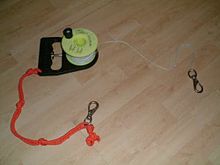
A distance line, penetration line, cave line, wreck line or guide line is an item of diving equipment used by scuba divers as a means of returning to a safe starting point in conditions of low visibility, water currents or where pilotage is difficult. They are often used in cave diving and wreck diving where the diver must return to open water after a penetration when it may be difficult to discern the return route.[1][2] Guide lines are also useful in the event of silt out.[3]

Distance lines are wound on to a spool or a reel for storage, and are laid in situ by unrolling.[4] The length of the distance line used is dependent on the plan for the dive. An open water diver using the distance line only for a surface marker buoy may only need 50 metres (160 feet), whereas a cave diver may use multiple reels of lengths from 25 ft (7.6 m) to 1000+ ft (300 m).
Reels for distance lines may have a locking mechanism, ratchet or adjustable drag to control deployment of the line and a winding handle to help keep slack line under control and rewind line. Lines are used in open water to deploy surface marker buoys and decompression buoys and link the buoy on the surface to the submerged diver, or may be used to allow easy return navigation to a point such as a shotline or boat anchor.
The material used for any given distance line will vary based on intended use, nylon being the material of choice for cave diving.[4] A common line used is 2 mm (0.079 in) polypropylene line when it does not matter if the line is buoyant.
The use of guide line for navigation requires careful attention to laying and securing the line, line following, marking, referencing, positioning, teamwork, and communication.[3]
- ^ Cite error: The named reference
Exleywas invoked but never defined (see the help page). - ^ Cite error: The named reference
Guideline 2was invoked but never defined (see the help page). - ^ a b Cite error: The named reference
Guideline 3was invoked but never defined (see the help page). - ^ a b Cite error: The named reference
Guideline 1was invoked but never defined (see the help page).
